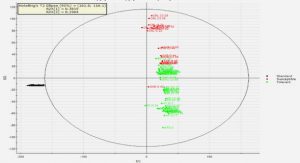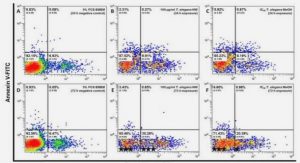Get Complete Project Material File(s) Now! »
Materials and methods
This research project consisted of several related experiments which aimed to understand how urban runoff affects aquatic microbial communities and to investigate the potential uses of stream biofilm as an indicator of the impact of urbanisation on freshwater ecosystems. Experiments were conducted in both flow chamber microcosms and in natural streams. Although all experiments followed different protocols to reach their specific aims, some techniques were used repetitively in several experiments. In this chapter, the different experimental systems used throughout the project and the main techniques used to analyse the samples are presented. Further details about each specific experimental design are given in the following chapters.
Experimental systems
Natural biofilms are generally complex associations of various species and types of organisms. Stream biofilms represent one of the most diverse forms of biofilms as they include numerous species of several types of organisms, including bacteria, algae and fungi. To investigate ecological processes occurring in biofilms, most research has so far looked at simplified biofilm systems comprised of one or a small number of species (O’Toole et al., 2000). In this project however, experiments were always carried out on complex biofilm communities directly obtained from natural streams or grown from the communities present in stream water.
Bacterial communities in stream biofilms are responsive to a wide range of environmental parameters (Besemer et al., 2007; Lear et al., 2008a; Lear & Lewis, 2009). In natural stream systems, factors such as flow rate, incident light and substrate type can vary across very small scales, providing a large diversity of microhabitats (Soininen, 2005). This can influence microbial communities and blur the results. Therefore, to allow a better control of environmental variables and provide a higher level of replication, several experiments were conducted in flow chamber microcosms, mainly in the first part of the project. Subsequent experiments were then carried out in actual streams to test the initial conclusions in the natural environment.
Flow chamber microcosms
Three types of flow chamber were used in the project.
The high capacity flow chamber system was filled with a relatively large volume of water (~400 litres) and included three parallel flow channels (200 cm [l] x 18 cm [w] x 11 cm [h]) in which a stream flow was simulated (Figure 2.1 & Figure 2.2). The water was collected in a large reservoir and circulated by a single water pump (Dynapond 7000, Davey Inc.). Because the water from all three channels was collected into the same tank and circulated by a single pump, this system did not allow the application of different chemical treatments. This system was used for growing homogeneous biofilm and investigating the recovery of bacterial populations after exposure to water contaminants. Further details about the use of the flow chambers will be given in the subsequent chapters.
To apply different chemical treatments, two systems of 10 separate low capacity flow chambers were used. In the first system, each flow chamber was filled with 17 litres of water and consisted of two interconnected tanks (Figure 2.3 & Figure 2.4). One tank (reservoir) contained a small pump (Watermaster pro, White International) that circulated the water through the system while the other (test tank) included an arrangement of grids and walls creating an homogeneous flow over a raised platform (21 cm x 14 cm). That area could hold three glass slides (6.5 cm x 14 cm) used as a substrate to grow biofilm.
A second system of 10 separate low capacity flow chambers consisted of a flow channel (150 cm [l] x 10 cm [w] x 7 cm [h]) and a single tank hosting a small water pump (Watermaster Pro, White International) (Figure 2.5 and Figure 2.6). Each chamber contained 18 litres of water. This setup provided the advantage of fitting 6 slides per chamber instead of 3 in the previous system. The channels could also host rocks that were directly collected from a stream, allowing the analysis of biofilm communities established on natural stream substrate.
Between successive experiments, to ensure no transfer of contaminants or bacteria, the flow chambers were washed twice, first with liquid detergent then with sodium hypochlorite (5%), rinsed twice and dried. Glass slides used as substrate to grow biofilm were also washed twice, soaked in 5M HNO3 for 24 h, rinsed and dried.
Natural stream sites
Although flow chambers were initially used to enable a better control of environmental variables, further experiments conducted in natural streams were needed to investigate the actual potential of biofilm as an indicator of urban impacts on stream health. A comparative study required multiple stream sites draining catchments variously impacted by urbanisation. Auckland Region was selected for its convenience as it includes numerous low impacted streams with catchments essentially dominated by forests or farmland as well as more impacted streams with different degrees of catchment urbanisation. More than 1 400 000 people live in the Auckland Region, most of them in the urbanised areas that covers approximately 11 % of the total surface (Auckland Regional Council monitoring programme 2009, http://monitorauckland.arc.govt.nz). This high density of population causes a great impact on urban streams. In contrast, rural areas have a low population density and streams are only slightly impacted by urbanisation. In total 28 different stream sites covering all types of catchments were sampled throughout the project (Figure 2.7). Further details about the sites are presented in the relevant following chapters.
Collection and handling of samples
The sampling process differed between experiments conducted in flow chamber microcosms or in actual stream sites. In flow chamber microcosms the process involved mainly collecting biofilm for molecular and metal analysis. Additional physico-chemical analyses such as pH, light and temperature were sometimes performed to confirm the homogeneity of environmental parameters in the different chambers. Water was also collected and analysed in some experiments to monitor variations in metal concentrations. In contrast, the sampling process in stream sites was usually more complex and could involve the collection of water, sediments and macro-invertebrates in addition to biofilm. Environmental parameters at each site were also monitored including light, temperature, dissolved oxygen, pH, flow rate, depth and width of the stream.
Biofilm sampling
For molecular analysis, biofilm samples were scraped off glass slides or individual rocks using Speci-Sponges™ (Nasco, U.S.A.). Speci-sponges™ are dry sponges exempt from any microbial DNA designed to absorb the suspension produced when rubbing wet surfaces. Sample substrates (e.g. glass slides) were carefully removed from the water before being rubbed vigorously with a Specie-Sponge. The sponges were placed into individual Whirl-Pak™ bags (Nasco, U.S.A.), which were sealed and transported to the laboratory in darkness on ice (when sampled from natural stream sites).
1 INTRODUCTION
1.1 Effect of urbanisation on freshwater ecosystems
1.2 Stream biofilms
1.3 Monitoring the impact of urbanisation on freshwater ecosystems 1
1.4 Research aims and objectives
2 MATERIALS AND METHODS
2.1 Experimental systems
2.2 Collection and handling of samples
2.3 Analysis of metal concentrations
2.4 Molecular analysis of microbial community structure and composition
2.5 Quantification of biofilm associated protozoa
2.6 Identification of macro-invertebrate species
3 FLOW CHAMBER EXPERIMENTS TO INVESTIGATE THE EFFECT OF URBAN RUNOFF METAL CONTAMINANTS ON BIOFILM MICROBIAL COMMUNITIES AND THEIR ACCUMULATION IN THE BIOFILM MATRIX.
3.1 Introduction
3.2 Experimental design
3.3 Results
3.4 Discussion
3.5 Conclusion
4 ANALYSIS OF METAL CONCENTRATIONS IN STREAM BIOFILM AND SEDIMENTS AND ASSESSMENT OF THEIR RELEVANCE AS INDICATORS OF METAL POLLUTION.
4.1 Introduction
4.2 Experimental design
4.3 Results
4.4 Discussion
4.5 Conclusions
5 RESILIENCE OF BIOFILM BACTERIAL COMMUNITIES OBTAINED FROM STREAMS VARIOUSLY IMPACTED BY ANTHROPOGENIC ACTIVITIES TO,COMMON METAL CONTAMINANTS OF URBAN RUNOFF.
5.1 Abstract
5.2 Introduction
5.3 Experimental design
5.4 Results
5.5 Discussion
5.6 Conclusions
6 EFFECT OF STORMWATER ON BIOFILM BACTERIAL COMMUNITIES INVESTIGATED IN FLOW CHAMBER MICROCOSMS.
6.1 Introduction
6.2 Experimental design
6.3 Results
6.4 Discussion
6.5 Conclusions
7 INVESTIGATION OF THE EFFECT OF URBANISATION ON STREAM ECOSYSTEMS USING BIOFILM MICROBIAL COMMUNITIES AND ASSOCIATED METALS AS INDICATORS OF THE CHANGES
7.1 Introduction
7.2 Experimental design
7.3 Results
7.4 Discussion
7.5 Conclusions
8 USE OF MICROBIAL BIOFILM TO MONITOR THE EFFICACY OF A STORMWATER TREATMENT TRAIN
8.1 Introduction
8.2 Experimental design
8.3 Results
8.4 Discussion
8.5 Conclusion
9 GENERAL CONCLUSION
9.1 Impact of urban runoff contaminants on biofilm microbial communities and implications for freshwater ecosystems
9.2 Use of biofilm microbial communities as an indicator of freshwater ecosystem health
9.3 Accumulation of metals in biofilms and implication for organisms grazing on biofilms
9.4 Use of biofilm associated metals as an indicator of their detrimental effect of on aquatic,biota
9.5 Applications and further research
10 APPENDICES
11 REFERENCES
GET THE COMPLETE PROJECT






